The varcos
Various authors used the metrics proposed by Ramus, Nespor & Mehler (1999) on more data and it soon become apparent that ΔC and above all ΔV are extremely sensible to certain variables such as speech rate. The interaction between the deltas and speech rate has been accurately studied by Dellwo & Wagner (2003), who hint at the possibility of using a new metric, the varcos, in order to normalize these effects: the values of the deltas are divided by the mean duration of (vocalic or consonantal) intervals, then multiplied by 100:

Expectations are of course similar to those for the deltas, so languages traditionally described as syllable-timed should present lower values of varcoC and varcoV than stress-timed languages. This idea is then reproposed and elaborated by Dellwo (2006).
Members of the staff of the Laboratory of Experimental Phonetics of Turin tried to compute these parameters on a broader sample of languages; the results are shown in the charts. The data consist of the narrative The North Wind and the Sun translated into various languages and read by professional or standard speakers (we have used some of the illustrations of the Handbook of the IPA and of the Journal of the IPA, but many samples have been recorded in our laboratory). The recordings have been accurately segmented and annotated independently by Antonio Romano and Paolo Mairano and the final results consist of the average of the values obtained by the two authors. Every dot in the chart corresponds to one speaker (except for Icelandic, for which we have 1 dot for 10 speakers to avoid confusion - the error bar indicates the standard deviation between the results obtained for each of the 10 speakers). The values of the correlates have been computed with the help of Correlatore, with which we have also built the charts.
Discussioni dettagliate dei risultati si trovano nelle nostre pubblicazioni in bibliografia. Si può tuttavia notare che le lingue tradizionalmente considerate isosillabiche (italiano, francese, spagnolo, ...) si collocano generalmente in basso a sinistra (quindi con valori bassi varcoC e varcoV), mentre le lingue tradizionalmente considerate isoaccentuali (inglese, tedesco, ...) si collocano in linea di massima in alto a destra (quindi con valori alti di varcoC e varcoV).

| Essential bibliography | |
|---|---|
| Dellwo, V. (2006) Rhythm and speech rate: a variation coefficient for deltaC. In Karnowski P. & Szigeti, I. (a cura di) Language and language processing. Francoforte sul Meno: Peter Lang, 231-241. | |
| Dellwo, V. & Wagner, P. (2003) Relations between language rhythm and speech rate. Atti dell'International Congress of Phonetic Science, Barcellona, 471-474. | |
| Mairano, P. & Romano, A. (2007) Inter-subject agreement in rhythm evaluation for four languages (English, French, German, Italian). Atti del XVI ICPhS (International Congress of Phonetic Sciences), Saarbrücken, Germania, 6-10 agosto 2007, 1149-1152. (PDF) | |
| Mairano, P. & Romano, A. (2007) Lingue isosillabiche e isoaccentuali: misurazioni strumentali su campioni di italiano, francese, inglese e tedesco. Atti del III Convegno Nazionale AISV (Associazione Italiana di Scienze della Voce), ITC-IRST Povo (TN), 29 novembre - 1 dicembre 2006. | |
| Mairano, P. & Romano, A. (2008) Distances rythmiques entre variétés romanes. In: Turculeţ, A. (a cura di) La variation diatopique de l’intonation dans le domaine roumain et roman, Iaşi: Edizioni Universitarie "Alexandru Ioan Cuza", 251-272. | |
| Mairano, P. & Romano, A. (2010) Un confronto tra diverse metriche ritmiche usando Correlatore. Atti del V Convegno Nazionale AISV (Associazione Italiana di Scienze della Voce), Università di Zurigo, 4-6 febbraio 2009. | |
| Romano, A., Mairano, P. & Pollifrone, B. (2010) Variabilità ritmica di varietà dialettali del Piemonte. Atti del V Convegno Nazionale AISV (Associazione Italiana di Scienze della Voce), Università di Zurigo, 4-6 febbraio 2009. | |
| Romano, A. & Mairano, P. (2010) Speech rhythm measuring and modelling: pointing out multi-layer and multi-parameter assessments. Atti del convegno Les Universaux Prosodiques, Université Sorbonne Nouvelle, Parigi, Francia, 15 ottobre 2008, Roma: Aracne Biblioteca di Linguistica |